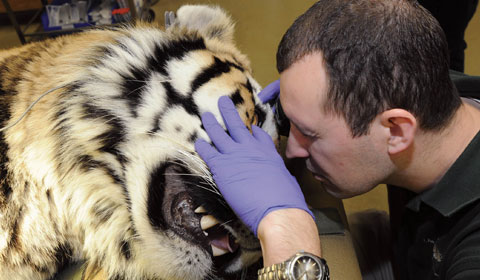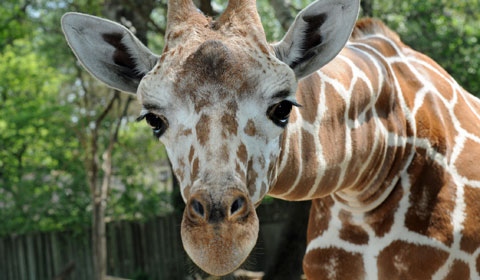News Release
Contact: Sondra Katzen, Public Relations, 708.688.8351,
sondra.katzen@czs.org
April 9, 2021
FOR IMMEDIATE RELEASE
Note to editor: Photos of the Humboldt penguin chicks are at the end of the release.
Four Humboldt Penguin Chicks Hatch at Brookfield Zoo
Brookfield, Ill.—The Bird Department staff at Brookfield Zoo has been busy caring for four Humboldt penguin chicks that hatched on March 13, 16, and 24, and April 3.
Animal care staff monitored the penguin pairs—Patty and Valentino, Chiquita and Milagro, Rosy and Divot, and Kukla and Ceviche—and when their eggs were laid, staff carefully removed the eggs and placed them in incubators. This was done to help improve the eggs’ chances of survival. At times, penguin colonies can be full of drama with birds bickering over mates and nesting sites, which has the potential to put eggs at risk of accidentally breaking. However, in order to not disrupt the adults natural behavior, artificial eggs are replaced for the real ones, allowing the parents to continue their incubation routine. The real eggs are returned to the parents or foster parents, once the hatching process begins.
Foster parenting, as was the case for three of the current penguin chicks, is considered for multiple reasons, including the parents are inexperienced and have never successfully raised a chick, or even to give a pair the opportunity to gain experience. Also, if a pair is genetically well represented in the accredited North American zoo and aquarium Humboldt penguin population, a recommendation to have them breed may not occur for a number of years. Being foster parents, gives them the opportunity to retain their nurturing skills. In addition, Humboldt penguins rear only one chick at a time, but a female may lay two eggs. In this situation, the second chick would be placed with foster parents to help ensure the survival of both chicks.
In the wild, Humboldt penguin parents typically stay and care for their chicks until the young are about 70 to 90 days old. The adults then leave the breeding ground and go off to sea, leaving their young to fend for themselves. To mimic the natural cycle as well as to improve the health and welfare of the birds, at Brookfield Zoo, when chicks reach a certain weight, animal care staff take over. The chicks still know they are penguins but the shift from parent-feeding to self-feeding makes for an easier transition on both the adults and the young birds.
The Chicago Zoological Society, which manages Brookfield Zoo, is a participant in the Association of Zoos and Aquariums’ Humboldt Penguin Species Survival Plan (SSP), which is a cooperative population management and conservation program. Each SSP manages the breeding of a species to maintain a healthy and self-sustaining population that is both genetically diverse and demographically stable. Including the four chicks, Brookfield Zoo currently has 34 Humboldt penguins. Guests can see them at the zoo’s Living Coast habitat.
According to IUCN’s (International Union for Conservation of Nature and Natural Resources) Red List, the species is “vulnerable” in its native habitat along the western coast of South America near Peru and Chile. The penguins’ population, which researchers estimate to be just under 24,000, continues to decline due to several factors, including climate change and severe weather, human encroachment, energy production and mining, as well as pollutants. For nearly 15 years, Dr. Mike Adkesson, vice president of clinical medicine for CZS, has led efforts in a conservation program at Punta San Juan, a marine protected area in Peru, which is home to wild populations of Humboldt penguins and other wildlife. The successful program focuses on sharing expertise with Peruvian veterinarians and marine biologists, promoting research, and engaging and educating the local communities about the ecosystem and why it is important to protect as well as the wildlife that inhabits the area.
# # #
Photo Captions (credit Cathy Bazzoni/CZS-Brookfield Zoo)
10 and
11: Four Humboldt penguin chicks recently hatched at Brookfield Zoo. Pictured are two that were born on March 13 and 16.
20: One of four Humboldt penguin chicks that recently hatched at Brookfield Zoo. The one pictured here was born on April 3.
22: Emily Venckus, an animal care specialist at Brookfield Zoo, weighs a Humboldt penguin chick that hatched on April 3.
About the Chicago Zoological Society
The mission of the Chicago Zoological Society is to inspire conservation leadership by engaging people and communities with wildlife and nature. The Chicago Zoological Society is a private nonprofit organization that operates Brookfield Zoo on land owned by the Forest Preserves of Cook County. The Society is known throughout the world for its international role in animal population management and wildlife conservation. Its Center for the Science of Animal Care and Welfare is at the forefront of animal care that strives to discover and implement innovative approaches to zoo animal management. Brookfield Zoo is the first zoo in the world to be awarded the Humane Certified™ certification mark for the care and welfare of its animals, meeting American Humane Association’s rigorous certification standards. The zoo is located at 8400 31st Street in Brookfield, Illinois, between the Stevenson (I-55) and Eisenhower (I-290) expressways and also is accessible via the Tri-State Tollway (I-294), Metra commuter line, and CTA and PACE bus service. For further information, visit
CZS.org.
MEDIA CONTACT:
Sondra Katzen
Media Relations Manager
Office: 708-688-8351
Cell Phone: 708-903-2071
E-mail: Sondra.Katzen@CZS.org

Read about our innovative practices in animal welfare to ensure the ultimate care of our individual animals.

Create extraordinary connections with animals and nature!

Become our partner in caring for animals and in connecting people with wildlife and nature.